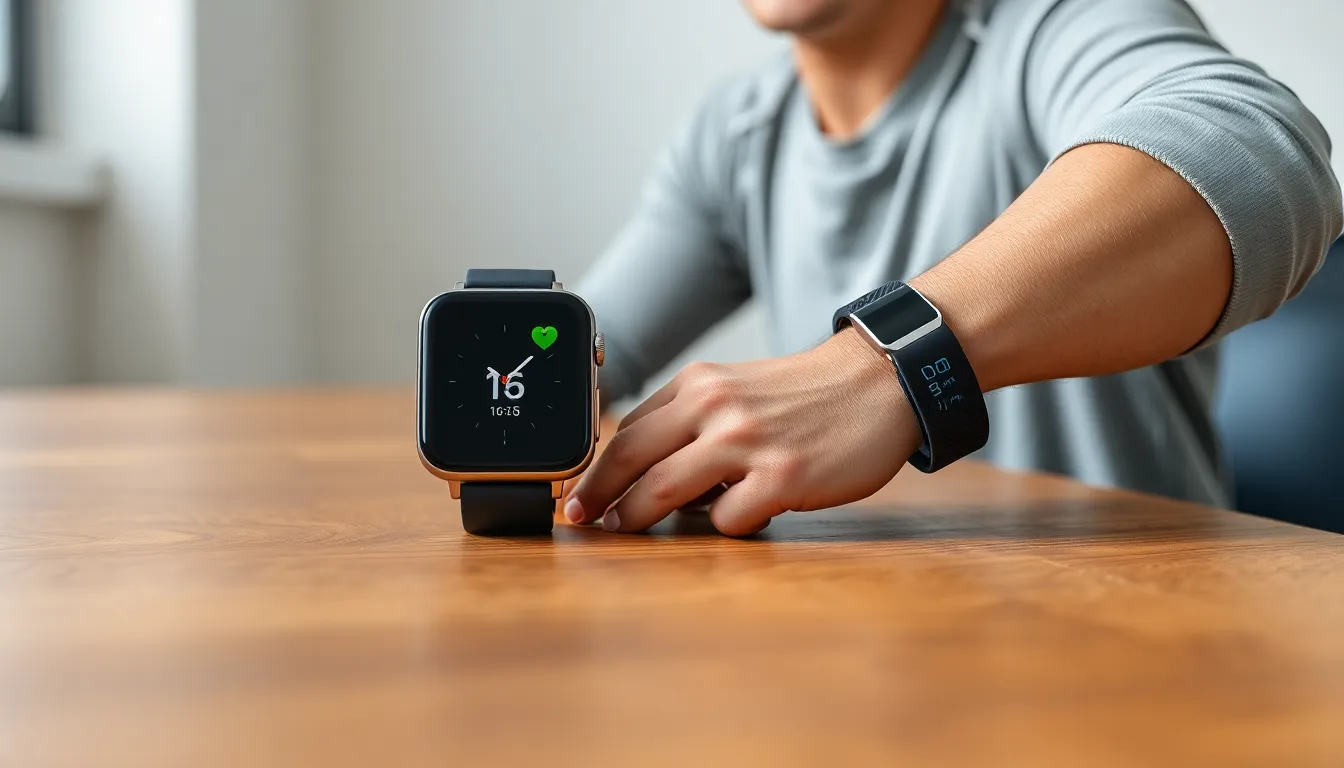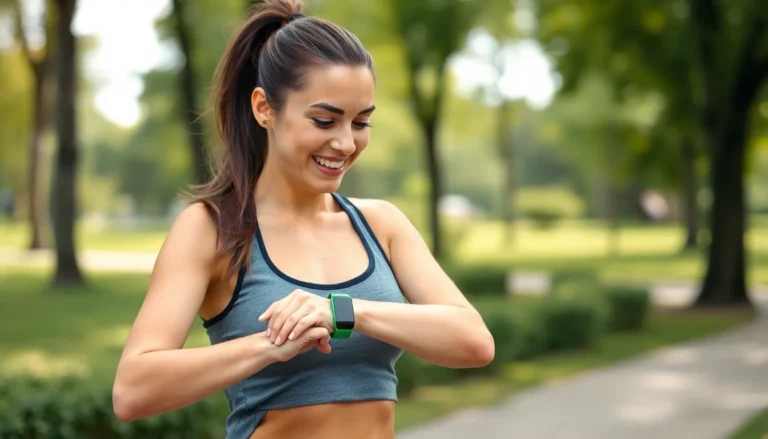In a world where checking your phone feels like a full-time job, wearable app devices swoop in like superheroes, ready to save the day. These nifty gadgets don’t just sit on your wrist; they’re your personal assistants, fitness trainers, and even your reminder to breathe—because let’s face it, life gets hectic!
Imagine tracking your steps while strutting your stuff or receiving notifications without digging through your bag like a raccoon on a mission. With wearable app devices, convenience meets style, and they’re here to make your life a little easier and a lot more fun. So if you’re ready to embrace the future and turn your daily routine into a high-tech adventure, it’s time to dive into the world of wearable tech.
Table of Contents
ToggleOverview of Wearable App Devices
Wearable app devices integrate seamlessly into daily life, serving various needs from fitness tracking to notification management. Smartwatches, fitness bands, and augmented reality glasses feature prominently in this market. Users often benefit from real-time data about health metrics like heart rate, steps, and sleep patterns.
Fitness bands focus on activity monitoring, pushing users toward their fitness goals. Notifications received on smartwatches allow users to stay connected without needing to access their phones. Augmented reality glasses enhance real-world experiences by overlaying digital information, making tasks more interactive.
Developers continuously innovate wearable technology, enhancing functionality and user experience. For instance, health apps now allow remote monitoring of vital signs, providing valuable insights for health management. Integration with smartphones increases usability, allowing users to customize their device experiences.
Widespread adoption reflects the growing trust in these devices’ reliability and accuracy. Statistics show that the global wearable device market is projected to reach $62 billion by 2025, illustrating consumer interest. This rising trend indicates users prioritize convenience and connectivity in their devices.
Adoption of wearable app devices promotes healthier lifestyles and efficient time management. Fitness objectives become achievable with features that track and report progress. Enhanced notifications streamline daily tasks, ensuring users stay organized throughout their day. By integrating technology into everyday routines, users can enjoy enriched experiences and improved overall well-being.
Types of Wearable App Devices

Various wearable app devices cater to specific needs, offering functionality and style. Here’s a closer look at the main types available.
Fitness Trackers
Fitness trackers focus primarily on monitoring physical activities. They record steps, track distance, and measure calories burned. Many include features like heart rate monitoring and sleep tracking, providing valuable insights into health and wellness. Popular brands, such as Fitbit and Garmin, continuously innovate, integrating new sensors and connectivity options. Users find these devices beneficial for setting and achieving fitness goals, promoting a more active lifestyle.
Smartwatches
Smartwatches combine traditional timekeeping with advanced technology. They provide notifications for calls, messages, and apps right on the wrist. Some models come equipped with GPS for navigation and music storage for seamless listening during workouts. Leading brands like Apple and Samsung enhance user experience through app integration and voice commands. These devices offer convenience, allowing individuals to stay connected without reaching for their smartphones.
Health Monitors
Health monitors specialize in tracking specific health metrics. These devices often include advanced sensors for measuring vital signs, such as blood pressure and blood sugar levels. Users with chronic conditions find them especially useful for remote monitoring and data sharing with healthcare providers. Devices like the Oura Ring and continuous glucose monitors exemplify this category’s innovation. By providing real-time health data, they empower individuals to take control of their health outcomes.
Key Features of Wearable App Devices
Wearable app devices offer a variety of features that enhance user experiences and provide valuable functionality. Key aspects include compatibility with smartphones, health and fitness tracking, and notifications and alerts.
Compatibility with Smartphones
Wearable app devices sync easily with smartphones, allowing users to access apps and features seamlessly. Users enjoy the convenience of receiving alerts and messages directly on their wrists. Integration with popular platforms facilitates instant updates, ensuring users stay connected at all times. Compatibility with both iOS and Android systems increases accessibility, making these devices versatile. Synchronization supports efficient data sharing between the wearable and smartphone, promoting better organization and user engagement.
Health and Fitness Tracking
Health and fitness tracking stands out as a crucial feature of wearables, appealing to health-conscious individuals. Many devices monitor heart rate, step count, and calories burned, offering insights that encourage active lifestyles. Users can track their sleep patterns to improve rest and recovery, promoting overall wellness. Advanced sensors provide accurate readings, enhancing the reliability of health data. By offering personalized fitness goals, these devices empower users to stay committed to their health journeys.
Notifications and Alerts
Notifications and alerts provide real-time updates, allowing users to manage their schedules without constantly checking smartphones. Wearable devices send alerts for incoming calls, messages, and calendar events, keeping users organized. Customizable settings allow users to select which notifications to receive, reducing distractions. Silent alerts, such as vibrations, ensure users stay informed without disturbing others. This feature enhances productivity by allowing users to prioritize tasks effectively.
Benefits of Using Wearable App Devices
Wearable app devices provide numerous advantages that enhance daily life. These gadgets significantly improve health management and offer unrivaled convenience and connectivity.
Improved Health Management
Wearable app devices track vital health metrics, aiding individuals in better health management. They monitor heart rate, track sleep patterns, and count steps, providing comprehensive insights. Users can rely on real-time data to adjust their fitness routines accordingly. Regular monitoring helps identify potential health issues early. Many devices also sync with health applications, enabling users to store and analyze their data over time. This access to health information encourages proactive health engagement. Their ability to facilitate personalized wellness goals promotes informed decision-making. Overall, wearable devices empower users to take charge of their health journey.
Convenience and Connectivity
Wearable app devices simplify daily tasks while enhancing connectivity. Users receive notifications for calls, messages, and calendar alerts straight from their wrists. They allow seamless interaction with smartphones, reducing the need to check devices frequently. Many gadgets also offer voice commands, promoting hands-free operation. Real-time updates keep users organized and focused, minimizing distractions. Fitness tracking features work in parallel with connectivity functions, supporting an active lifestyle without compromise. Additionally, wearables integrate a variety of applications to suit individual needs. This blend of convenience and connectivity cultivates a more productive daily routine.
Challenges and Limitations
Challenges and limitations exist within the realm of wearable app devices. Understanding these issues helps users make informed decisions.
Battery Life Concerns
Battery life remains a critical hurdle for many wearable devices. Users often face the inconvenience of frequent charging, limiting continuous use. Typical smartwatches and fitness bands typically last 1 to 7 days on a single charge, depending on features used. Some advanced functionalities, such as GPS tracking, drain battery life more quickly. Many consumers express frustration over short usage times that hinder long-term tracking and engagement. Manufacturers strive to enhance battery technology, yet the balance between features and longevity often proves difficult.
Data Privacy Issues
Data privacy poses significant concerns with wearable technology. Many users share personal health and activity data, potentially exposing sensitive information. Companies that develop these devices typically collect varied data types, ranging from location to health metrics. If not properly secured, this information could be vulnerable to breaches. Users expect strong protection measures to maintain trust. Regulations like GDPR emphasize the importance of data privacy, prompting companies to adapt their strategies. Addressing these issues effectively remains essential to ensuring long-term user safety and confidence.
Wearable app devices are transforming how individuals approach daily life and health management. By seamlessly integrating technology into personal routines they empower users to stay organized and active. The growing trust in these devices reflects a shift toward prioritizing convenience and wellness.
As technology continues to evolve so do the features and capabilities of wearable devices. This ongoing innovation promises to enhance user experiences further making health management more accessible and efficient. While challenges like battery life and data privacy remain it’s clear that the benefits of wearable technology outweigh the drawbacks.
Embracing these devices can lead to a healthier lifestyle and improved productivity allowing users to make the most of their time and well-being.



